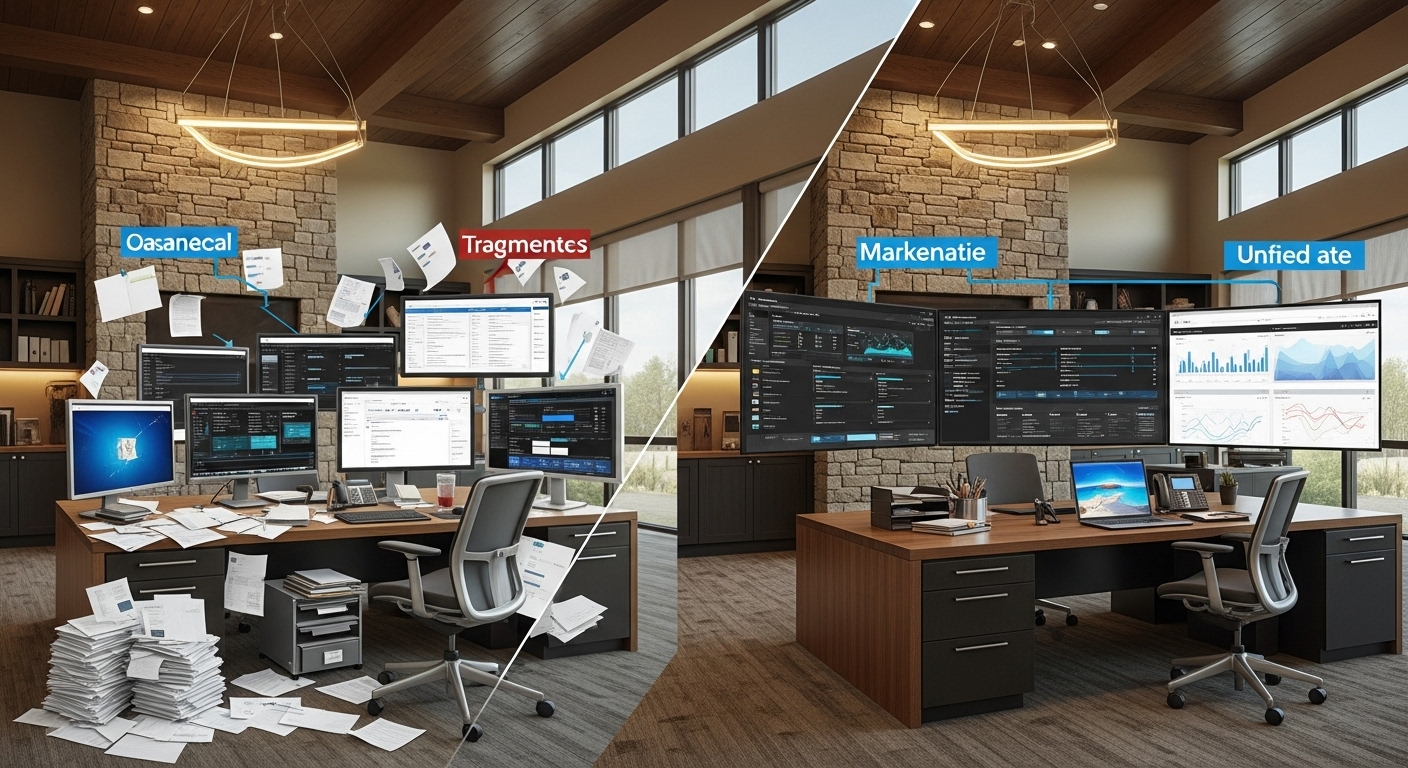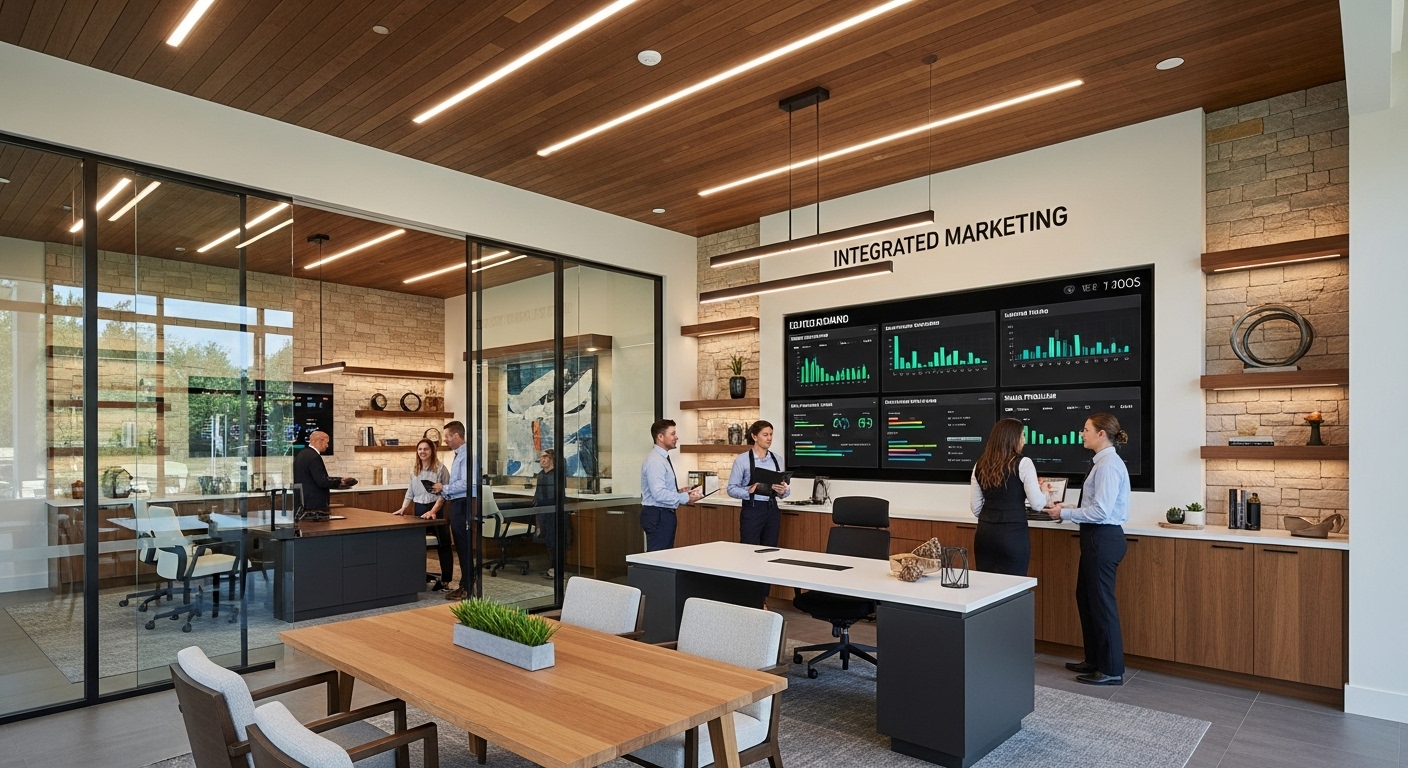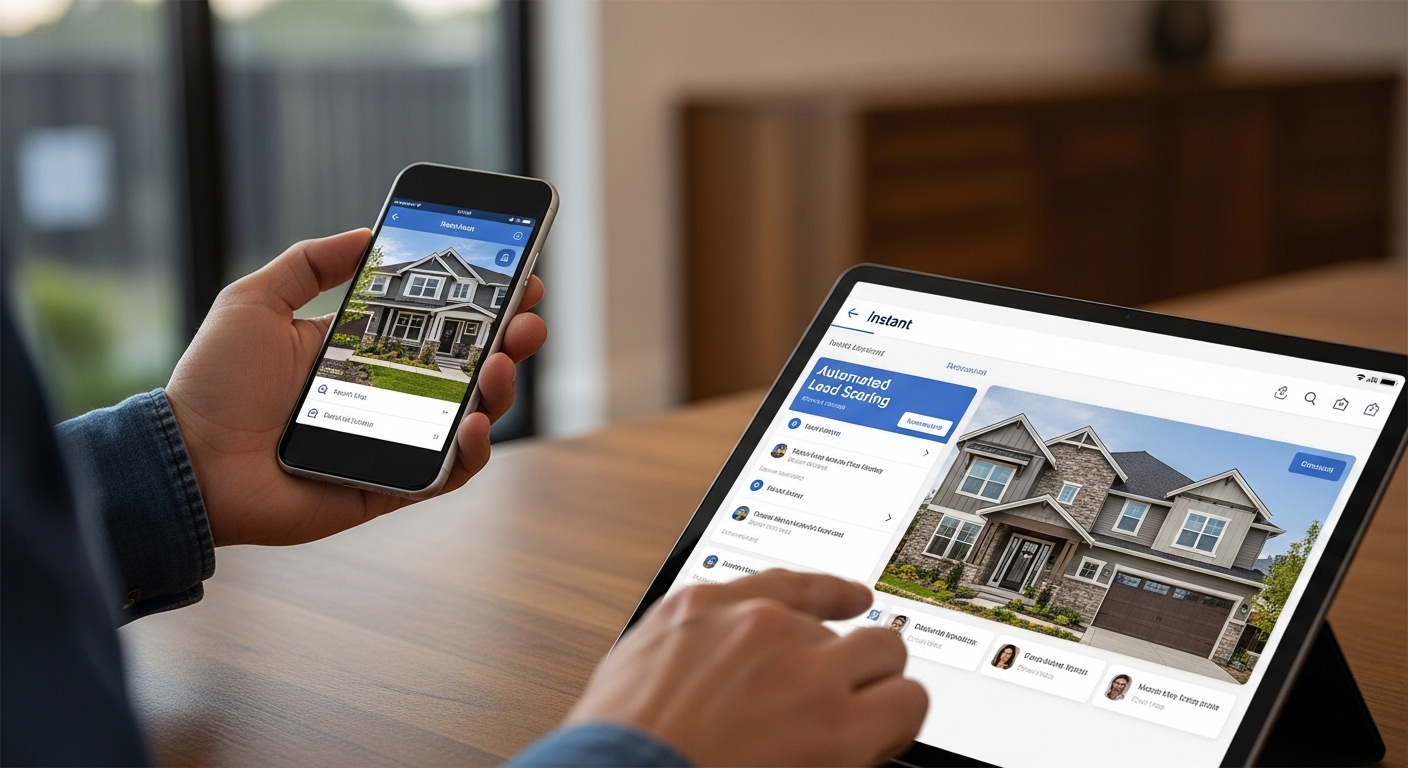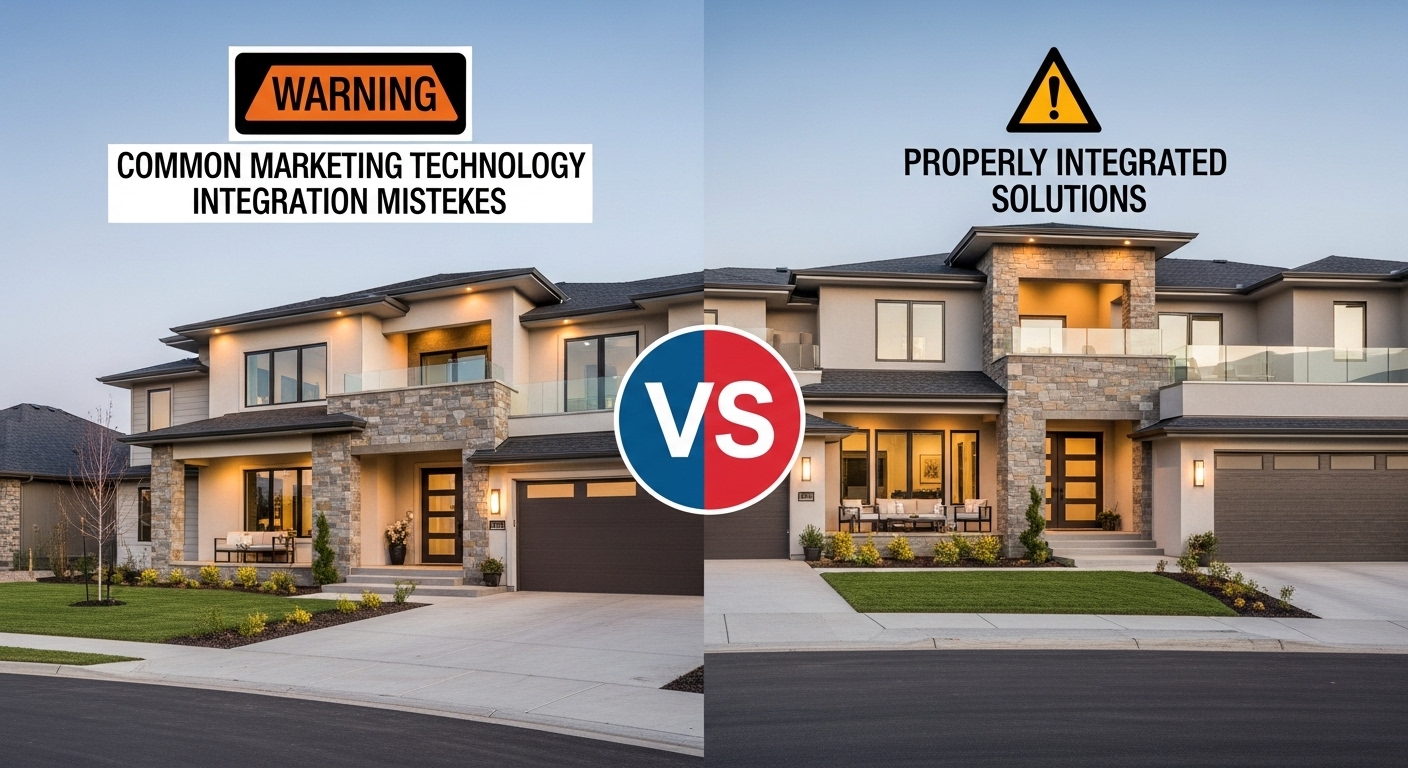August 11, 2025 by 100XBuilds Team
Marketing Technology Integration: Automation Best Practices

When Meridian Custom Homes integrated their marketing technology stack last year, they reduced lead response time from 4 hours to 8 minutes while increasing qualified lead conversion by 67%. The secret wasn't spending more on marketing—it was connecting the pieces they already had.
Most luxury builders operate with marketing technology that resembles a collection of islands rather than a connected ecosystem. Your CRM talks to your email platform sometimes. Your website captures leads that disappear into spreadsheets. Your sales team works from different data than your marketing team. This fragmentation costs you deals, wastes marketing spend, and creates the kind of operational friction that prevents scaling past $10M in revenue.
The Hidden Cost of Disconnected Systems

The average mid-market builder uses 12-15 different software platforms across marketing, sales, and operations. Without proper integration, each platform becomes a data silo that requires manual intervention to extract value.
Consider the typical lead journey in a disconnected system:
Lead enters through website form → Manual export to spreadsheet → Manual import to CRM → Manual assignment to sales rep → Manual follow-up tracking → Manual reporting
Each manual step introduces delay, human error, and lost opportunities. Industry data shows that 78% of leads go to the company that responds first, yet most builders take 2-4 hours for initial contact.
The real cost breakdown:
Administrative overhead: 15-20 hours per week on data entry and reconciliation
Lost leads: 35-40% of qualified leads never receive proper follow-up
Delayed response time: Average 3.2 hours vs. industry best practice of under 15 minutes
Reporting accuracy: Manual reporting is typically 20-30% inaccurate due to human error
Foundation: Establishing Your Integration Architecture
Before connecting systems, you need a clear architecture that defines how data flows between platforms. Think of this as the blueprint for your technology ecosystem.

Core System Hierarchy
Customer Relationship Management (CRM): Your single source of truth for all prospect and customer data
Marketing Automation Platform: Handles lead nurturing, email campaigns, and behavioral tracking
Website and Landing Pages: Primary lead capture and qualification interface
Analytics and Reporting: Unified dashboard for performance measurement
Communication Tools: Phone, text, and video platforms for prospect engagement
Data Flow Mapping
Map every touchpoint where prospect data is created, modified, or accessed:
Lead capture points: Website forms, phone calls, referrals, trade shows
Qualification stages: Initial interest, budget confirmation, timeline establishment
Sales process steps: Consultation scheduled, proposal sent, contract negotiation
Post-sale touchpoints: Project management, change orders, completion
Each touchpoint should automatically update your central database without manual intervention.
Integration Strategy: Connecting the Ecosystem

Phase 1: CRM as Central Hub
Your CRM should serve as the central nervous system for all prospect and customer data. Every other system should either send data to or receive data from your CRM.
Essential CRM integrations:
Website forms: Automatic lead capture with source tracking
Email marketing: Behavioral triggers based on CRM data
Phone system: Call logging and recording integration
Calendar scheduling: Automatic appointment creation and confirmation
Proposal software: Contract status updates and e-signature tracking
Phase 2: Marketing Automation Workflows
Once your CRM is receiving clean data, build automated workflows that respond to prospect behavior and sales activities.
High-impact automation workflows:
New lead response: Instant email acknowledgment + SMS notification to sales rep + calendar link for consultation
Lead nurturing sequences: Behavior-triggered email series based on project type and timeline
Sales follow-up automation: Automatic reminders for proposal follow-up, contract review, and project milestone communication
Re-engagement campaigns: Automated outreach to dormant leads based on original inquiry date and project timeline
Phase 3: Advanced Integration Features
Lead scoring integration: Combine website behavior, email engagement, and demographic data to prioritize sales efforts
Dynamic content personalization: Website and email content that adapts based on CRM data and browsing history
Attribution tracking: Connect marketing activities to closed deals across multiple touchpoints
Predictive analytics: Use historical data to identify the highest-probability prospects
Automation Best Practices for Luxury Builders

Lead Response Automation
Immediate acknowledgment: Automated email response within 60 seconds of form submission
Sales notification: Instant SMS and email alert to assigned sales rep with lead details
Qualification routing: Automatic assignment based on project type, location, and budget range
Follow-up scheduling: Calendar integration that allows prospects to book consultations immediately
Nurturing Sequence Automation
Project-specific content: Automated email series tailored to custom homes, renovations, or commercial projects
Timeline-based messaging: Content delivery based on stated project timeline (6 months, 1 year, 2+ years)
Behavioral triggers: Automated responses to website visits, email opens, and content downloads
Sales handoff automation: Seamless transition from marketing to sales with complete activity history
Operational Efficiency Automation
Reporting automation: Daily, weekly, and monthly performance reports delivered automatically
Data cleanup: Automated duplicate detection and merge processes
Task management: Automatic task creation for sales follow-up, proposal delivery, and contract milestones
Communication logging: Automatic recording of all prospect interactions across channels
Measuring Integration Success

Key Performance Indicators
Response time metrics:
Average time to first contact: Target under 15 minutes
Lead acknowledgment time: Target under 2 minutes
Proposal delivery time: Target within 48 hours of consultation
Conversion metrics:
Lead-to-consultation conversion: Industry benchmark 15-25%
Consultation-to-proposal conversion: Industry benchmark 60-75%
Proposal-to-contract conversion: Industry benchmark 25-35%
Operational efficiency metrics:
Data entry time reduction: Target 80% reduction through automation
Reporting preparation time: Target 90% reduction through automated dashboards
Administrative task reduction: Target 15-20 hours per week savings
ROI Calculation Framework
Direct cost savings:
Administrative time savings: Hours saved × average hourly cost
Improved conversion rates: Additional closed deals × average project value
Faster sales cycles: Revenue acceleration from reduced time-to-close
Technology investment recovery:
Integration setup costs: One-time implementation investment
Monthly platform costs: Ongoing subscription and maintenance fees
Training and adoption costs: Team education and process development
Most mid-market builders see 300-500% ROI within 12 months of proper integration implementation.
Implementation Roadmap
Month 1-2: Foundation Setup
CRM configuration: Clean existing data and establish proper field structure
Integration planning: Map current systems and identify connection points
Team training: Ensure all users understand new processes and workflows
Month 3-4: Core Integrations
Website-to-CRM connection: Implement automatic lead capture and routing
Email marketing integration: Connect behavioral triggers and nurturing sequences
Communication platform integration: Enable automatic call logging and SMS capabilities
Month 5-6: Advanced Automation
Lead scoring implementation: Develop and deploy qualification algorithms
Advanced workflow creation: Build complex automation sequences for different prospect types
Reporting dashboard creation: Establish unified performance measurement system
Ongoing Optimization
Monthly performance review: Analyze metrics and identify improvement opportunities
Quarterly system audit: Ensure all integrations are functioning properly and data quality remains high
Annual strategy review: Evaluate new technology opportunities and integration possibilities
Common Integration Pitfalls to Avoid

Data quality issues: Garbage in, garbage out—clean your existing data before integration
Over-automation: Maintain human touchpoints for high-value prospects who expect personal attention
Insufficient testing: Always test integrations with sample data before full deployment
Inadequate training: Team adoption is critical—invest in comprehensive training programs
Neglecting mobile optimization: Ensure all integrated systems work seamlessly on mobile devices
The luxury home building industry demands sophisticated marketing technology that matches the caliber of your craftsmanship. Disconnected systems create the kind of operational friction that prevents growth and frustrates both prospects and team members.
Integration isn't just about connecting software—it's about creating a seamless experience that allows your team to focus on what they do best: building relationships and delivering exceptional homes. When your technology works as a unified system, you can respond faster, nurture more effectively, and close more deals while reducing administrative overhead.
Ready to transform your marketing technology from a collection of tools into a powerful, integrated growth engine? Contact 100XBuilds today to discuss your integration strategy and discover how proper technology architecture can accelerate your path to $10M+ in annual revenue.
